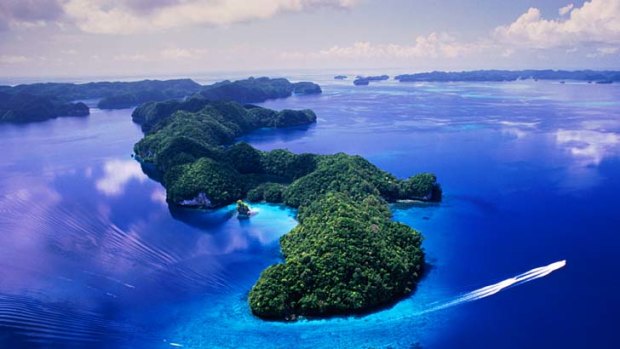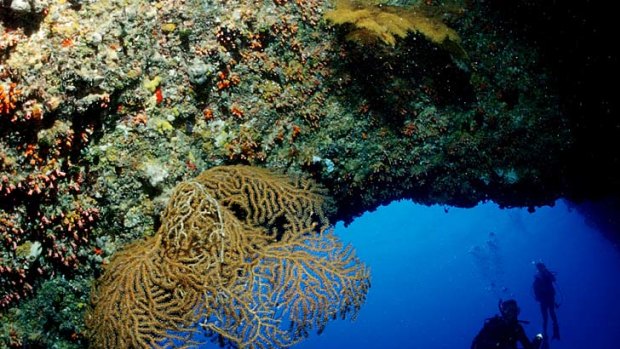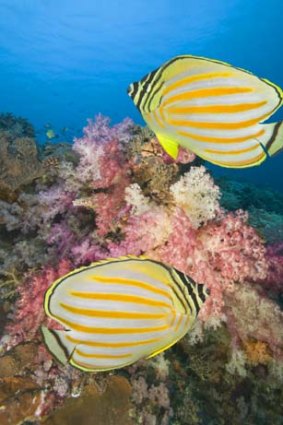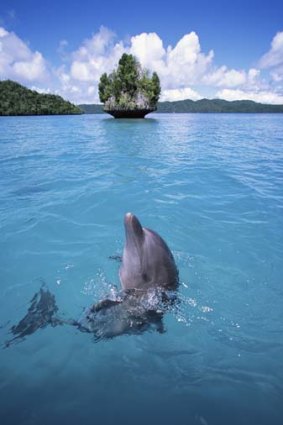This was published 12 years ago
Adventures in blue
Lee Atkinson faces her underwater fears swimming with sharks and jellyfish in Palau, one of the world's most beautiful underwater destinations.

The Rock Islands from the air.Credit: Getty Images
"Don't kick the jellyfish," says the sign at the wharf. Sounds easy enough but when you are confronted with a wall of gently pulsating jelly it can be pretty hard not to bump one or two out of the way as you swim through the mass.
Diving into a lake full of jellyfish in the tiny Micronesian nation of Palau is one of the weirdest things I have ever done. It's a leap of faith that plays tricks with your head. As an Australian, I'm hardwired to go out of my way to avoid all sea creatures with tentacles and even though I've been assured that the jellyfish have only a "mildly noticeable sting" that, at worst, may make my lips swell up like Angelina Jolie's, I am mildly hyperventilating with anxiety as I don snorkel and mask and jump in.
These golden jellyfish, trapped in an enclosed lake in the middle of a steep-sided rock island formed when an ancient reef was pushed out of the sea during an earthquake, have, over millennia, lost their ability to sting, thanks to a lack of predators. Obtaining their energy by photosynthesising sunlight, they follow the sun around the lake, congregating en masse where the sun is the brightest.

Diving at Blue Holes.Credit: Getty Images
At first, as you start swimming across the shady section and towards the middle of the lake, it takes a while for your eyes to adjust to the murkiness of the water and it's easy enough to keep out of the way of the one or two jellyfish that float past. But as the water becomes less gloomy, and you realise that it's not sunlight that has turned the water white but thousands of jellyfish, it feels like an impenetrable barrier that you really should swim around, not through. Before you know it you are in the middle of a perfect jellyfish swarm, countless soft blobs brushing up against your bare arms and legs. And while I couldn't quite bring myself to reach out and cradle one in my hands like some of my fellow snorkellers, I'm happy to report that the "mildly noticeable sting" wasn't noticeable at all although, disappointingly, my lips stayed as thin as they ever were (I really wouldn't have minded a little more pout).
You need to like being in the water and have a healthy sense of adventure to really enjoy Palau. Even the climb up the steep razor-edged coral track that leads up over the hill and down into Jellyfish Lake is a challenge, especially if you are wearing rubber thongs like I was (wear joggers or enclosed shoes).
Part of the Caroline Islands group in Micronesia, and made up of a string of some 300 limestone and coral islands in the western Pacific between Guam and the Philippines, Palau was controlled first by the Spanish, then the Germans before it was awarded to the Japanese at the end of World War I in the Treaty of Versailles. It was won, after a prolonged and bloody battle, by the US during World War II. It became an independent nation in 1994.
The sharks are of the big-but-harmless variety.
Palau doesn't get a lot of tourists and those who do visit are mainly Japanese, Taiwanese and Korean. It's a place that hasn't really made a mark on the Australian travelling radar. At first glance it's easy to see why. There are no direct flights from Australia; Palau is a two-hour flight from Guam and the only direct flights between Guam and Australia (four and a half hours' flying time) leave from Cairns, although you can fly direct from Palau to Manila if you want to island hop your way across the western Pacific to Asia.
Unlike the more popular and easily accessible Pacific and southern-Asia holiday destinations such as Fiji, Vanuatu, New Caledonia, Bali and Thailand, there are next to no beaches (apart from small man-made slivers of sand at a couple of the more upmarket resort hotels), shopping is non-existent, there's not much nightlife (apart from hotel cultural shows) and the few local restaurants there are either cater mainly for Japanese and Korean tour groups (kimchi, sushi, buffets and bento boxes), or offer local delicacies such as clam pancakes and fruit bat soup, which are both a bit of an acquired taste.
Palau is, however, one of the most beautiful places I have ever visited. Home to just 20,000 people, only nine of the 300 or so islands are inhabited; the others are sheer-sided, jungle-clad towers of rock that rise out of a warm, crystal clear sea.

Water world ... a World War II relic.Credit: Getty Images
Those seas are the real reason to come to Palau. Teeming with tropical fish, turtles, manta rays, sharks (Palau was the world's first shark sanctuary), extensive coral reefs and World War II wrecks, Palau is on the top of every serious scuba diver's bucket list. If you love floating about in bath-warm water looking at things and getting up close and personal with a whole lot of fish, you'll love Palau. As far as underwater destinations go, it blows most other Asia-Pacific destinations out of the water; sharks, wrecks and coral aside, it's the only place where you can swim with millions of stingless jellyfish. And if you like your island paradises to come without crowds, hawkers, noisy nightclubs and drunken yobbos, you'll love it even more.
The most famous of the dive sites is Blue Corner. Here, the prevailing current carries schools of fish into a channel formed by a wall of coral, the large numbers of fish in turn attracting large numbers of sharks.
As the only non-diver in our group, I drifted with the current among the fish on the surface with a snorkel and mask and watched my colleagues hook themselves to the reef below as 20 or so rather large looking grey sharks surrounded them, like a group of hungry diners descending on the seafood at an all-you-can-eat buffet. Distracted by a swirl of movement nearby, I clamoured back into the boat just in time to see three sharks tear apart a large fish in a feeding frenzy just metres away from where we had first entered the water.

Butterflyfish swim over a soft coral reef.Credit: Getty Images
After half an hour or so the divers surfaced, elated and euphoric; I can only assume it didn't look as alarming from the bottom as it did from above. The sharks, I'm told, are of the big-but-harmless variety, although whether the same can be said for the small tiger shark one of the group spotted I'm not so sure.
The day before we had explored the big island of Babeldaob by ATV (all terrain vehicle) on old Japanese roads that were more like hiking trails or rivers of mud, thanks to a tropical downpour earlier in the morning. What had started off tamely enough as we drove through the streets of Koror, Palau's main town, soon became hardcore adventure as we slipped and skidded through the jungle to the rusted-out remains of a Japanese tank, abandoned at the top of a hill during World War II. Can't say I blame them; I didn't much feel like negotiating the track back down either. It was only back in town, most of us covered in mud and soaked to the skin, when we returned the vehicles that I noticed the self-drive tour was labelled "extreme".
In between these adventures we had snorkelled more coral reefs and swum through more schools of fish than we could count, had a natural spa at a place called the Milky Way, where we daubed ourselves with white clay and washed it off by diving into the milky blue water, drank cocktails on a sunset cruise while we watched young girls wearing coconut bras sing and dance to pop songs and eaten fruit bat, although that's not something I'd be keen to try again; it tastes like mouldy liver.

A Bottlenose dolphin plays in the water.Credit: Getty Images
On our final day we explore the Rock Islands by kayak, paddling into limestone caves festooned with stalagmites and around the mushroom-shaped islands of the bay, peering through the water at the sunken remains of World War II aircraft, snorkelling along the reef walls that cling to the underside of the islands, swimming through rocky caverns that open up into magical semi-enclosed coral gardens and hiking up hills to find crumbling Japanese lookout posts and gun emplacements littered with empty sake bottles.
Our guide was disappointed we didn't see any saltwater crocodiles but as far as I'm concerned, kayaking with crocodiles is a just a little bit too Bear Grylls for me.
The writer was the guest of United Airlines, Visit Palau and the Guam Visitors Bureau.
Three things to do in Guam
To get to Palau you'll need to stopover in Guam — flights from Australia arrive early in the morning, flights out to Palau don't leave until late in the evening and vice versa on the way back. But there are plenty of ways to fill the time.
1 Get wet There are worse ways to spend a day than sitting by the pool. Head to Tumon beach for snorkelling, windsurfing and kayaking in the lagoon. The Pacific Island Club, Guam's largest hotel, has several pools, including a kids splash park, swim-through aquarium and water adventure park with water slides and waterfalls, as well as tennis courts, indoor climbing wall and racquetball courts. Day passes are available. picresorts.com/guam.
2 Revisit the war Guam was the scene of fierce fighting during World War II and there's plenty for those with an interest in military history. The Pacific War Museum is worth a look and there are a number of historic sites scattered around the island. Head down to Pirates Cove (jeffspiratescove.com) for lunch to learn about Sergeant Shoichi Yokoi, the last of the Japanese WWII stragglers to be captured in 1972. nps.gov/wapa.
3 Meet the locals The Chamorro are the indigenous people of Guam. Go to Proa Restaurant for a taste of the local cuisine (dishes to try include Chamorro red rice, Kelaguen, hibachi-style barbecue and the red hot fina denne dipping sauce). Spend the afternoon at the Lina'la Chamorro Cultural Park on Gun Beach, Tumon, and then head next door to The Beach Bar for a sunset cocktail or two. visitguam.org; theguamguide.com.
Top 5 dive sites
There are more than 20 "must-see" dive sites sprinkled around the islands of Palau. Here's the top five according to the divers in our group:
1 Blue Corner Sharks, wahoo, tuna, hawksbill and green turtles, eagle rays, giant groupers and barracuda but for most people, it's all about getting close to lots and lots of sharks.
2 Blue Holes Probably the next most popular site in Palau, after Blue Corner. Dive through one of the four holes on top of the reef into a large underwater cave.
3 Helmet Wreck Just two or three minutes from the dive shops of Koror. The name of the ship, sunk during the war, is unknown, but it's full of guns, live ammunition, helmets (hence the name) and other wartime cargo.
4 German Channel A deep channel funnels the outgoing and incoming tides from the inner lagoon: expect to see manta rays and plenty of fish.
5 Big Drop Off A good one for beginners, a drift dive along a wall of beautiful coral.
Trip notes
Getting there
United Airlines flies weekly to Guam from Cairns with daily connections to Palau and onward to Manila. united.com.
Staying there
Best hotels are the Palau Royal Resort (www.palau-royal-resort.com, rooms from $205) and Palau Pacific Resort (palauppr.com, rooms from $US295 ($286)). Both feature small beaches, swimming pools, spa facilities and rooms with water views.
Touring there
There is no shortage of tour companies that will take you to all the main diving and snorkelling sites and other popular places like Jellyfish Lake, however many are more comfortable working in Japanese than English and are tailored to groups. Best for English speakers travelling independently are Fish 'n Fins (fishnfins.com) for water-based tours and ATV tours while Sam's Tours (samstours.com) does a great kayaking tour of the Rock Islands.
Need to know
Visas are issued on arrival in Palau but as Guam is part of the US you will need to obtain an electronic visa waiver to visit Guam 72 hours before arrival. usaevisitors.com. Best time to dive is October-May.
More information
Sign up for the Traveller Deals newsletter
Get exclusive travel deals delivered straight to your inbox. Sign up now.